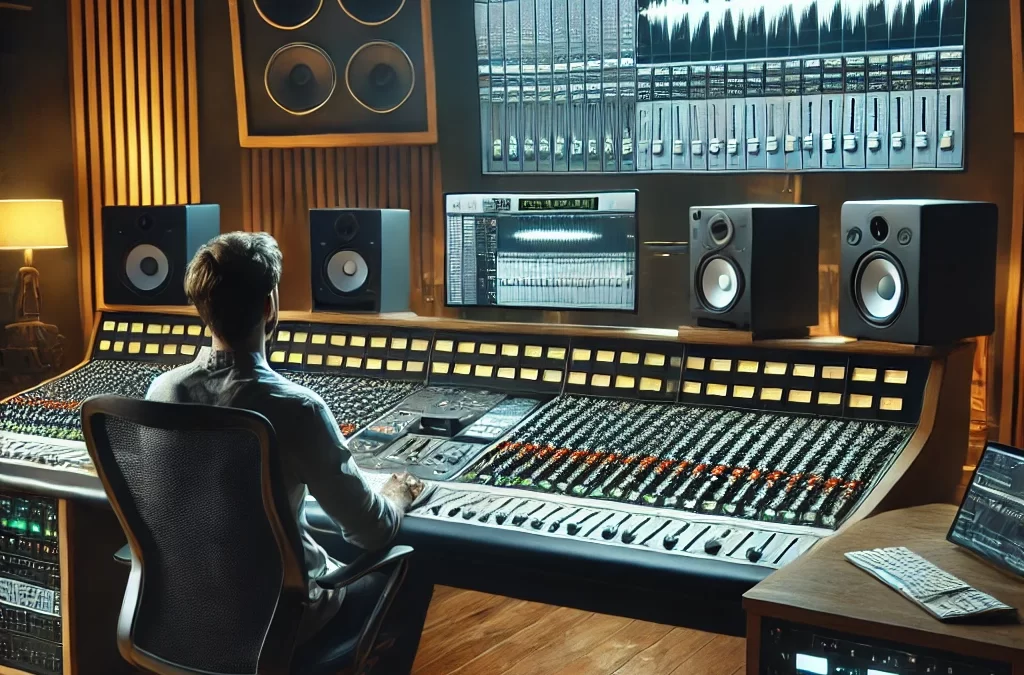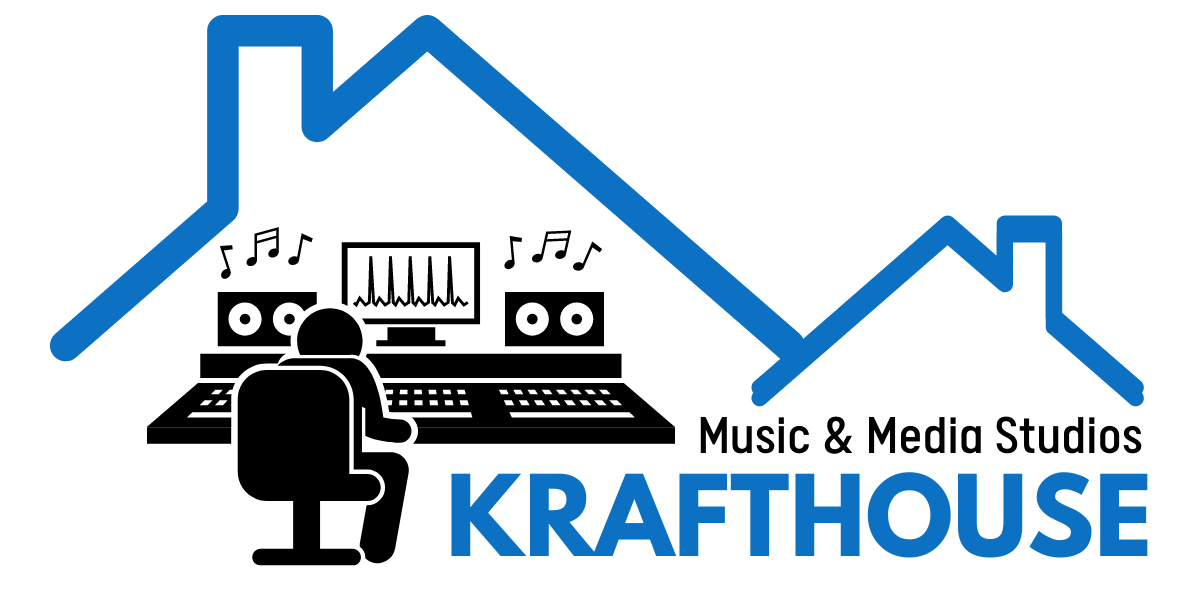

Mixing at studio London
Mixing and mastering are essential processes that transform raw recordings into polished, professional-quality music. Understanding the difference between the two and knowing best practices can help you achieve a radio-ready sound.
What is Mixing?
Mixing is the process of balancing all the elements in a song. This includes adjusting volume levels, applying equalization (EQ), compression, reverb, and panning.
What is Mastering?
Mastering is the final step that ensures your track is sonically consistent across different playback devices. It involves final EQ adjustments, stereo enhancement, and loudness optimization.
Essential Mixing Techniques
– Use reference tracks to compare your mix with professional songs.
– Apply EQ to remove unwanted frequencies and create clarity.
– Control dynamics with compression to balance volume levels.
– Pan instruments for a wider stereo field and depth.
Mastering Best Practices
– Avoid over-compression, which can squash the dynamics.
– Optimize loudness for streaming platforms like Spotify and Apple Music.
– Apply stereo widening carefully to maintain clarity.
At Krafthouse, we offer professional mixing and mastering services that ensure your tracks meet industry standards. Book your session today!

Choosing the right recording studio can make a huge difference in the quality of your music. London has a wealth of studios, but not all are created equal. Whether you’re an independent artist, a band, or a producer, selecting a studio that fits your needs is crucial.
The right studio can provide high-end recording equipment, an acoustically treated space, and an experienced sound engineer to help bring your vision to life. However, making the wrong choice can lead to wasted money and an unsatisfactory end product.
1. Consider the Equipment and Technology
A professional studio should have industry-standard microphones, preamps, mixing consoles, and digital audio workstations (DAWs) such as Pro Tools, Logic Pro, or Ableton Live. The studio’s gear list should be readily available, so always check what’s included in your session.
2. Engineer Experience Matters
A high-end studio means nothing if the sound engineer lacks experience. A knowledgeable engineer can guide you through the recording process, suggest the best microphone techniques, and help with the mixing and mastering stages.
3. Acoustic Treatment and Studio Environment
Soundproofing and acoustic treatment significantly impact recording quality. A professional studio should have isolation booths, bass traps, and acoustic panels to control reverb and reflections.
4. Reviews and Testimonials
Before booking, read online reviews and ask other musicians for recommendations. Studios with consistently high ratings are more likely to deliver professional results.
5. Pricing vs. Quality
A cheaper studio may seem like a good deal, but sacrificing quality could cost you more in the long run. Balance affordability with professionalism.
At Krafthouse, we offer state-of-the-art equipment, experienced engineers, and a creative atmosphere to help you achieve the best recording possible. Book a session today and take your music to the next level.
Dropping music without a plan is like throwing a message in a bottle and hoping someone finds it. I’ve seen too many artists put their heart into creating a track, only to release it with zero strategy—no build-up, no marketing, and no reason for listeners to care. A proper release strategy maximises reach, boosts engagement, and turns casual listeners into long-term fans. If you want your music to actually make an impact, you need a structured plan.
The first step is setting a release date and working backwards. A well-planned rollout takes at least four to six weeks, giving you enough time to create anticipation and momentum. Rushing a release might feel exciting in the moment, but without preparation, your track is likely to get lost in the noise. Having a clear timeline ensures you hit all the necessary promotional steps before your music even drops.
Creating pre-release hype is crucial. Tease your track with snippets, behind-the-scenes content, and interactive posts. Platforms like TikTok and Instagram Reels are great for short-form content that hooks new listeners. Share the songwriting process, let fans vote on artwork, or drop exclusive previews for your core audience. The more invested people feel in your journey, the more likely they are to support your release. ️
A well-executed pre-save campaign can make a huge difference. Encouraging fans to pre-save your song on Spotify and Apple Music helps trigger algorithms, increasing the chances of your track landing on editorial and algorithmic playlists. Use incentives like exclusive content or giveaways to drive pre-saves and convert casual listeners into engaged fans.
Playlisting should be a major part of your release strategy. Submitting your track to Spotify for Artists at least two weeks before release gives it a chance to be considered for editorial playlists. Additionally, reaching out to independent curators on Spotify, YouTube, and Apple Music can help place your track in front of thousands of potential listeners. The right playlist feature can turn a small release into a viral moment.
Running targeted ads before and after your release helps amplify reach. Instagram, Facebook, and YouTube ads allow you to put your music in front of your ideal audience. The key is storytelling—don’t just promote the song, promote the emotion and experience behind it. Ads that show the inspiration behind a track, live reactions, or high-energy clips perform better than a simple ‘out now’ post.
On release day, go all in. Engage with your audience, respond to every comment, and encourage fans to share. Hosting a live Q&A, going live on social media, or dropping a visualiser/video keeps the energy high. First-day engagement is key to triggering streaming algorithms, so get as many people talking about your release as possible. ️
Finally, don’t let the hype die after release day. Too many artists release a song and move on, but the real work starts after the drop. Keep promoting with alternative content—remixes, acoustic versions, user-generated content, and collaborations. Pushing your track for at least four to six weeks post-release ensures longevity and increases the chances of it catching momentum.
At Krafthouse, we help artists plan structured release strategies that maximise impact. A great song deserves the right rollout, and with the right plan, you can turn every release into a career-building moment.
Creating great music is only part of the equation—getting it in front of the right audience is what makes an artist successful. I’ve seen countless talented musicians drop incredible tracks only for them to go unnoticed because they didn’t have a marketing strategy in place. In today’s industry, marketing isn’t an afterthought—it’s an essential part of your career. Whether you’re an independent artist or working with a team, smart marketing can amplify your reach, boost engagement, and turn listeners into loyal fans.
The first step in music marketing is understanding your audience. If you’re promoting your music without knowing who your listeners are, you’re shooting in the dark. Research your fanbase—what age group are they? Where do they hang out online? What type of content do they engage with the most? Tailoring your marketing to your specific audience makes every promotional effort more effective.
Social media is a non-negotiable tool for music marketing, but too many artists use it incorrectly. Simply posting links to your songs isn’t enough. The key is consistent engagement and storytelling. Use platforms like Instagram, TikTok, and Twitter to give fans a glimpse into your creative process, behind-the-scenes moments, and personal experiences. The more authentic and engaging your content is, the more likely people are to share, comment, and connect with your music.
Content marketing is another powerful way to build your audience. Music videos, lyric breakdowns, reaction videos, and studio vlogs keep fans engaged between releases. A strong content strategy ensures you stay relevant even when you’re not dropping new music. Leveraging platforms like YouTube and TikTok to create engaging short-form and long-form content can massively increase visibility. ️
Playlisting is a game-changer when it comes to exposure. Getting featured on Spotify, Apple Music, and YouTube playlists can introduce your music to thousands of potential fans. Submit your songs to Spotify for Artists before release, pitch to independent curators, and network with playlist managers. The right playlist placement can boost streams and attract new listeners overnight.
Paid advertising is one of the fastest ways to scale your music’s reach. Running Facebook, Instagram, and YouTube ads can help target the right audience. The mistake most artists make is pushing their music without a strategy—instead, craft ad campaigns that tell a story. Ads that showcase your personality, your journey, or an engaging moment from your music video will perform much better than a simple “Stream Now” ad.
Collaborations are also a powerful marketing tool. Working with other artists, producers, or influencers expands your audience and brings new fans to your music. Whether it’s a feature, a remix, or a joint live stream, collaborations create buzz and cross-promotion opportunities. Networking with influencers and content creators who align with your sound can also help amplify your reach.
Email marketing remains one of the most underrated yet effective marketing strategies. Unlike social media, where algorithms control your visibility, an email list gives you direct access to your fans. Offering exclusive content like early music releases, discounts on merch, or VIP experiences through email helps build a loyal and engaged fanbase.
At Krafthouse, we help artists develop strategic marketing plans that go beyond just posting links. Music marketing is about engagement, storytelling, and creating lasting relationships with your audience. If you want real results, invest in marketing the same way you invest in your music.
The music industry isn’t just about talent—it’s about who you know and how you connect. You could be the most skilled producer, engineer, or artist, but if nobody knows you exist, opportunities will be limited. Networking isn’t about just handing out business cards or spamming people with links to your music; it’s about building real relationships that open doors. The most successful artists and producers didn’t make it alone—they built solid connections that helped them grow.
The first rule of networking? Provide value before asking for anything. Too many artists and producers reach out to industry professionals with nothing but a request—“check out my track,” “give me a feature,” or “put me on.” Instead, approach networking with a collaborative mindset. Offer your skills, support their work, and build rapport before expecting favours. When people see that you’re genuinely invested, they’re more likely to return the energy. ️
Events, whether in-person or virtual, are some of the best places to network. Music conferences, industry panels, launch parties, and networking events are full of people who can help you grow. Don’t just be a spectator—introduce yourself, have real conversations, and follow up. If you’re attending an event, do some research beforehand on who will be there, so you can make strategic connections. The goal isn’t to meet the most people—it’s to make the right connections with those who align with your career path.
Social media has changed networking forever, making it easier than ever to connect with producers, engineers, A&Rs, managers, and other artists. Platforms like Instagram, Twitter, and LinkedIn allow you to engage with industry professionals without needing to be in the same city. But the key is genuine interaction—comment on their posts, share their content, and engage with them in a way that isn’t just self-serving. When the time is right, sliding into their DMs with a thoughtful message (not just “Yo, let’s work”) can lead to actual opportunities.
Collaboration is one of the strongest forms of networking. Working with like-minded artists, producers, and creatives expands your audience and builds credibility. If you’re a producer, reach out to artists and offer beats—if you’re a singer, work with different songwriters and engineers. Every collab brings exposure to a new network, and sometimes, a simple collaboration can be the breakthrough moment that leads to bigger opportunities.
Another underrated but powerful strategy is providing value to gatekeepers. Music journalists, playlist curators, radio DJs, and influencers play a massive role in getting music heard. Instead of just sending them your music, build a real connection—support their work, share their content, and develop a relationship before asking them for a favour. The same goes for industry professionals like managers, booking agents, and A&Rs. Build trust first, and the opportunities will follow.
Following up is a crucial part of networking that most people ignore. Just because you met someone at an event or had a quick DM exchange doesn’t mean the connection is solid. Follow up with a short, personalised message reminding them of your conversation and expressing your interest in staying connected. Keeping in touch over time, whether through casual check-ins or by engaging with their content, keeps you on their radar.
At Krafthouse, we believe networking is a skill every artist and producer needs to master. The right connections can transform your career, but only if you approach it the right way—with authenticity, patience, and a willingness to provide value. If you want to build a sustainable music career, start building real relationships today. ️
In today’s music industry, talent alone isn’t enough—you need a strong brand. I’ve seen incredible artists struggle to get noticed simply because they never took branding seriously. Your brand isn’t just your logo or social media aesthetic; it’s the way people connect with you, recognize your music, and remember you. When done right, branding makes you stand out, attract the right audience, and create long-term loyalty.
Branding starts with your story. People don’t just connect with music—they connect with the artist behind it. What’s your journey? What makes your music different? Why should people care? These are the questions you need to answer before crafting your brand. Your personality, background, struggles, and wins all contribute to your identity as an artist. The most successful musicians don’t just sell songs; they sell a narrative that fans can relate to.
Your visual identity plays a massive role in branding. From your logo and album covers to your photoshoots and music videos, everything should feel consistent. Think about how Travis Scott’s dark, moody aesthetics, Billie Eilish’s neon green visuals, or The Weeknd’s retro styling help define their brand. Even your fashion choices and stage presence are part of your branding. Make sure your visuals reflect the energy and message of your music.
Consistency is key when it comes to social media. Too many artists post randomly with no strategy. If someone visits your Instagram, TikTok, or YouTube, they should instantly understand your vibe, your genre, and your personality. Your content should tell a story—whether it’s behind-the-scenes footage, snippets of new music, personal reflections, or fan interactions. Engaging with your audience builds trust and keeps them invested in your journey.
Your music and branding should align. If your music is dark and introspective, your visuals and messaging should match that. If you’re creating high-energy party anthems, your brand should reflect that excitement. Look at how Drake, J. Cole, and Doja Cat all have distinct branding that’s reflected in their music, visuals, and marketing. When everything aligns, your brand feels natural and authentic.
Building a brand also means developing a signature sound. This doesn’t mean every song has to sound the same, but listeners should be able to recognize your style. Whether it’s a specific vocal tone, production style, or lyrical theme, find what makes your music unique and emphasize it. A strong brand means people know what to expect when they see your name—just like how people instantly recognize a Pharrell beat or a Kendrick Lamar verse. ️ ️
Collaboration is another powerful way to strengthen your brand. Working with like-minded artists, producers, and influencers exposes you to new audiences and helps build credibility. Features, joint projects, and even simple co-signs can elevate your status in the industry. Just make sure every collaboration fits your brand—aligning with the wrong artist can dilute your image.
Finally, branding isn’t just about image—it’s about building a community. The most successful artists create movements, not just music. They give their fans something to be a part of. Whether it’s a catchphrase, a unique way of engaging with fans, or an exclusive fan club, having a deeper connection with your audience creates long-term loyalty. Fans who feel personally connected to you are the ones who will stream your music, buy your merch, and show up to your shows.
At Krafthouse, we help artists develop powerful branding strategies that go beyond just making music. If you want a real career in this industry, branding isn’t optional—it’s the foundation for everything else. Your music might get people to listen, but your brand is what makes them stay.



